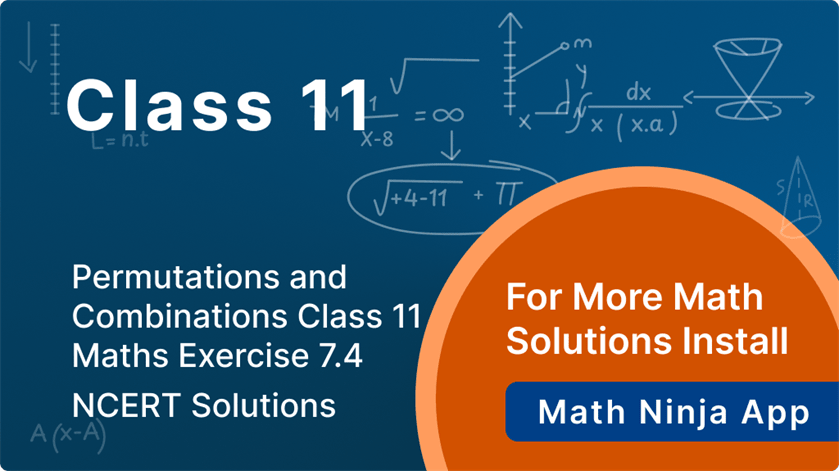Class 11 maths exercise 7.4 solutions | exercise 7.4 class 11 maths solutions | class 11 ch 7 exercise 7.4 solutions | class 11 chapter 7 exercise 7.4 solution | class 11 maths ncert solutions chapter 7 | ncert solutions for class 11 maths chapter 7 | ncert exemplar class 11 maths | permutation and combination class 11
Looking for Class 11 Maths Exercise 7.4 solutions? You’re in the right place! This section provides detailed and easy-to-understand solutions to all the questions from Exercise 7.4 of Chapter 7 – Permutations and Combinations. These solutions are based on the latest NCERT syllabus and cover advanced applications of both permutations and combinations, including mixed problems and real-life scenarios. Whether you’re referring to the Class 11 Ch 7 Exercise 7.4 solutions, solving problems from the NCERT Exemplar Class 11 Maths, or revising the complete topic of Permutation and Combination Class 11, these solutions will help you sharpen your analytical thinking. Download or explore the NCERT Solutions for Class 11 Maths Chapter 7 and take your preparation to the next level!

exercise 7.4 class 11 maths solutions || ncert exemplar class 11 maths || class 11 maths ncert solutions chapter 7 || class 11 ch 7 exercise 7.4 solutions || permutation and combination class 11 || class 11 chapter 7 exercise 7.4 solution || class 11 maths exercise 7.4 solutions || ncert solutions for class 11 maths chapter 7
Exercise 7.4
Therefore,
\({ }^{n} C_{8}={ }^{n} C_{2}=n=8+2=10\)
\(\therefore n_{C_{8}}=10_{C_{2}}=\frac{10!}{2!(10-2)!}=\frac{10!}{2!8!}=\frac{10 \times 9 \times 8!}{2 \times 1 \times 8!}=45\)
2.
\(=\frac{(2 n)!}{3!(2 n-3)!} \times \frac{3!(n-3)!}{n!}=\frac{12}{1}\)
\(=\frac{2(2 n-1)(2 n-2)}{(n-1)(n-2)}=12\)
\(=\frac{4(2 n-1)(n-1)}{(n-1)(n-2)}=12\)
\(=\frac{(2 n-1)}{(n-2)}=3\)
\(=2 \mathrm{n}-1=3(\mathrm{n}-2)\)
\(=2 n-1=3 n-6\)
\(=3 n-2 n=-1+6\)
\(=\mathrm{n}=5\)
\(=\frac{(2 n)(2 n-1)(2 n-2)(2 n-3)}{(2 n-3)!} \times \frac{(n-3)!}{n(n-1)(n-2)(n-3)!}\)
\(=\frac{2(2 n-1)(2 n-2)}{(n-1)(n-2)}=11\)
\(=\frac{4(2 n-1)(n-1)}{(n-1)(n-2)}=11\)
\(=\frac{4(2 n-1)}{n-2}=11\)
\(=4(2 n-1)=11(\mathrm{n}-2)\)
\(=8 \mathrm{n}-4=11 \mathrm{n}-22\)
\(=11 \mathrm{n}-8 \mathrm{n}=-4+22\)
\(=3 \mathrm{n}=18\)
\(=\mathrm{n}=6\)
exercise 7.4 class 11 maths solutions || ncert exemplar class 11 maths || class 11 maths ncert solutions chapter 7 || class 11 ch 7 exercise 7.4 solutions || permutation and combination class 11 || class 11 chapter 7 exercise 7.4 solution || class 11 maths exercise 7.4 solutions || ncert solutions for class 11 maths chapter 7
To know the number of chord that can be drawn through the given 21 points on a circle, the number of combinations have to be counted.
Therefore, there will be as many chord as there are combinations of 21 points taken 2 at a time.
Thus, required number of chord \( ={ }^{23} \mathrm{C}_{2}=\frac{2!}{2!19!}=\frac{21 \times 20}{2}=210 \)
3 boys can be selected from 5 boys in \( { }^{5} \mathrm{C}_{3} \) ways.
3 girls can be selected from 4 girls in \( { }^{4} \mathrm{C}_{3} \) ways.
Therefore, by multiplication principle, number of ways in which a team of 3 boys and 3 girls can be selected \( ={ }^{5} \mathrm{C}_{3} \times{ }^{4} \mathrm{C}_{3}=\frac{5!}{3!2!} \times \frac{4!}{3!1!} \)
\(=\frac{5 \times 4 \times 3!}{3!\times 2} \times \frac{4 \times 3!}{3!}=10 \times 4=40\)
exercise 7.4 class 11 maths solutions || ncert exemplar class 11 maths || class 11 maths ncert solutions chapter 7 || class 11 ch 7 exercise 7.4 solutions || permutation and combination class 11 || class 11 chapter 7 exercise 7.4 solution || class 11 maths exercise 7.4 solutions || ncert solutions for class 11 maths chapter 7
9 balls have to be selected in such a way that each selected consists of 3 balls of each colors.
Here,
3 balls can be selected from 6 red balls in \( { }^{6} \mathrm{C}_{3} \) ways.
3 balls can be selected from 5 white balls in \( { }^{5} \mathrm{C}_{3} \) ways.
3 balls can be selected from 5 blue in \( { }^{5} \mathrm{C}_{3} \) ways.
Thus, by multiplication principle, required number of ways of selecting 9 balls.
\(={ }^{6} \mathrm{C}_{3} \times{ }^{5} \mathrm{C}_{3} \times{ }^{5} \mathrm{C}_{3}=\frac{6!}{3!3!} \times \frac{5!}{3!2!} \times \frac{5!}{3!2!}\)
\(=\frac{6 \times 5 \times 4 \times 3!}{3!\times 3 \times 2} \times \frac{5 \times 4 \times 3!}{3!\times 2 \times 1} \times \frac{5 \times 4 \times 3!}{3!\times 2 \times 1}\)
\(=20 \times 10 \times 10=2000\)
Then, one ace can be selected in \( { }^{4} \mathrm{C}_{3} \) ways and the remaining 4 cards can be selected out of the 48 cards in \( { }^{48} \mathrm{C}_{4} \) ways.
Thus, by multiplication principle, required number of 5 cards combination
\(={ }^{48} \mathrm{C}_{4} \times{ }^{4} \mathrm{C}_{1}=\frac{48!}{4!44!} \times \frac{4!}{1!3!}\)
\(=\frac{48 \times 47 \times 46 \times 45}{4!\times 3 \times 2 \times 1} \times 4!\)
\(=778320\)
A cricket team of 11 players is to be selected in such a way that there are exactly 4 bowlers.
4 bowlers can be selected in \( { }^{5} \mathrm{C}_{4} \) ways and the remaining 7 players can be selected out of the 12 players in \( { }^{12} \mathrm{C}_{7} \) ways.
Thus, by multiplication principle, required of ways of selecting cricket team
\(={ }^{5} \mathrm{C}_{4} \times{ }^{12} \mathrm{C}_{7}=\frac{5!}{4!1!} \times \frac{12!}{7!5!}=5!\times \frac{12 \times 11 \times 10 \times 9 \times 8}{5!\times 4 \times 3 \times 2 \times 1}=3960\)
2 black balls can be selected out of 5 black balls in\( { }^{5} \mathrm{C}_{2}\) ways and 3 red balls can be selected out of 6 red balls in \({ }^{6} \mathrm{C}_3\) ways.
Thus, by multiplication principle, required number of ways of selecting 2 black and 3 red balls
\(={ }^{5} \mathrm{C}_{2} \times{ }^{6} \mathrm{C}_3=\frac{5!}{2!3!} \times \frac{6!}{3!3!}=\frac{5 \times 4}{2} \times \frac{6 \times 5 \times 4}{3 \times 2 \times 1}=10 \times 20=200\)
Therefore, every student has to choose 3 courses out of the remaining 7 courses. This can be chosen in \( { }^{7} \mathrm{C}_{3} \) ways.
Thus, required number of ways of choosing the programmer
\(={ }^{7} \mathrm{C}_{3}=\frac{7!}{3!4!}=\frac{7 \times 6 \times 5 \times 4!}{3 \times 2 \times 1 \times 4!}=35\)

